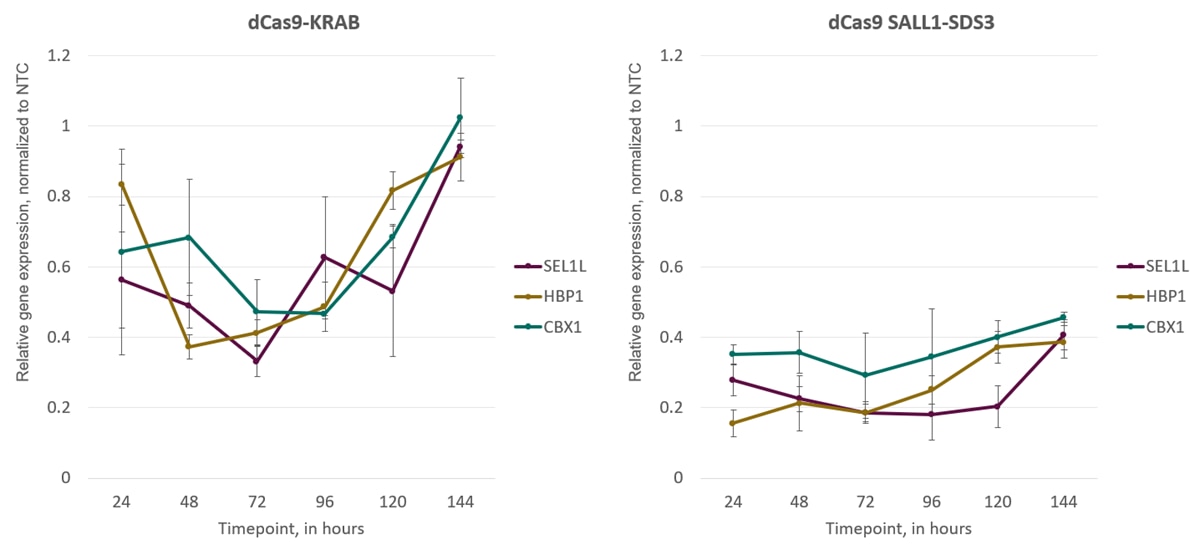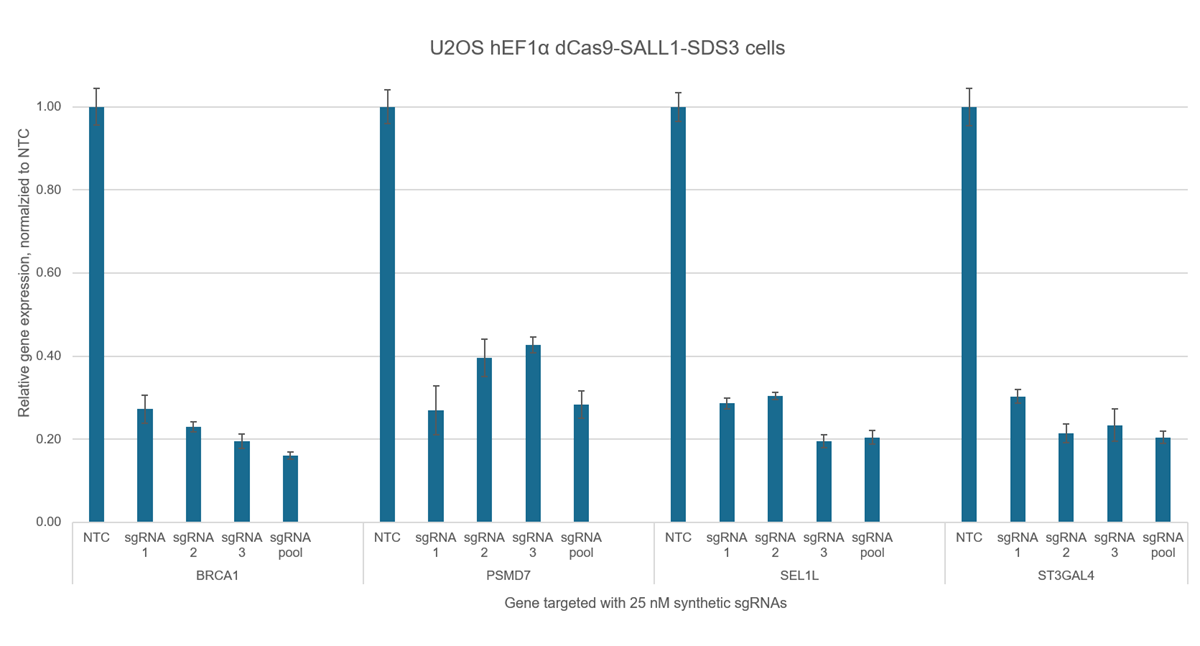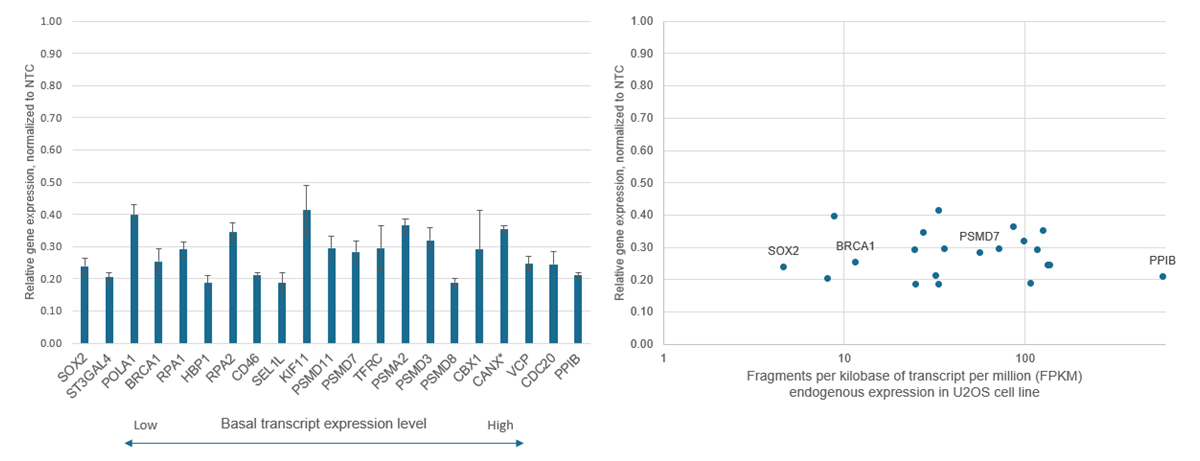- CRISPR interference reagents
- CRISPRi synthetic sgRNA
CRISPRmod CRISPRi synthetic sgRNA
Predesigned CRISPRi guide RNAs for highly specific gene repression of any human protein-coding gene
- Our CRISPRi system has been developed to outperform other systems (KRAB and MECP2) when combined with synthetic guides - observe repression within 24 hours post-transfection
- Co-transfect or electroporate with CRISPRi dCas9-SALL1-SDS3 mRNA for a lentiviral-free CRISPRi workflow
- Available as pooled or individual reagents

CRISPRi synthetic sgRNA
1Start Here
2Choose
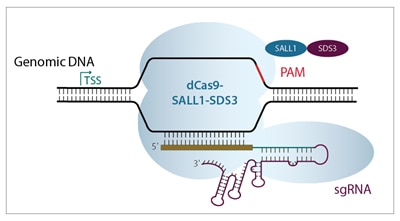
Diagram of CRISPRi-based transcriptional repression
Efficient transcriptional gene repression with CRISPRi
CRISPR interference (CRISPRi) is a unique adaptation of the CRISPR-Cas9 gene editing system. The Horizon CRISPRmod CRISPRi system utilizes a catalytically deactivated Cas9 (dCas9) fused to our proprietary transcriptional repressors (SALL1 and SDS3). When paired with an algorithm-designed guide RNA that targets a gene immediately downstream of the transcriptional start site (TSS), it promotes transcriptional repression.
Review our CRISPRi applications page to see an overview of the technology!
Highlights of CRISPRi synthetic sgRNA reagents
- CRISPR-based PAM-anchored targeting provides highly specific transcriptional repression (see Supporting data tab)
- Designs optimized from a published algorithm by Horlbeck, et. al. demonstrate strong levels of gene repression (see References tab)
- Chemically modified CRISPRi sgRNAs provide additional stability against nuclease degradation and improve overall performance
- For genes with alternative characterized start sites, distinct guide RNA designs are available (labeled P2)
Requirements for a CRISPRi experiment using synthetic sgRNA
- CRISPRi synthetic sgRNA for your target gene - choose from individual guides, sets of 3 guides, or pools of 3 guides
- CRISPRi dCas9-SALL1-SDS3 source - choose from mRNA or lentiviral particles (see Workflow tab)
- Appropriate positive and non-targeting controls
- DharmaFECT transfection reagent or electroporation for guide delivery
Co-transfect or electroporate cells with CRISPRi synthetic sgRNA and CRISPRi dCas9-SALL1-SDS3 mRNA. Then enrich cell populations using fluorescence or puromycin resistance options. This system is best suited for rapid, transient gene repression studies.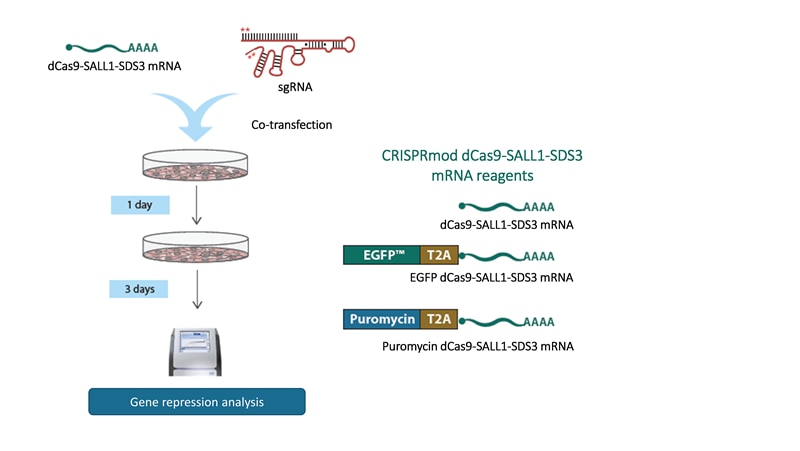
CRISPRi workflow using synthetic sgRNA and dCas9-SALL1-SDS3 mRNA
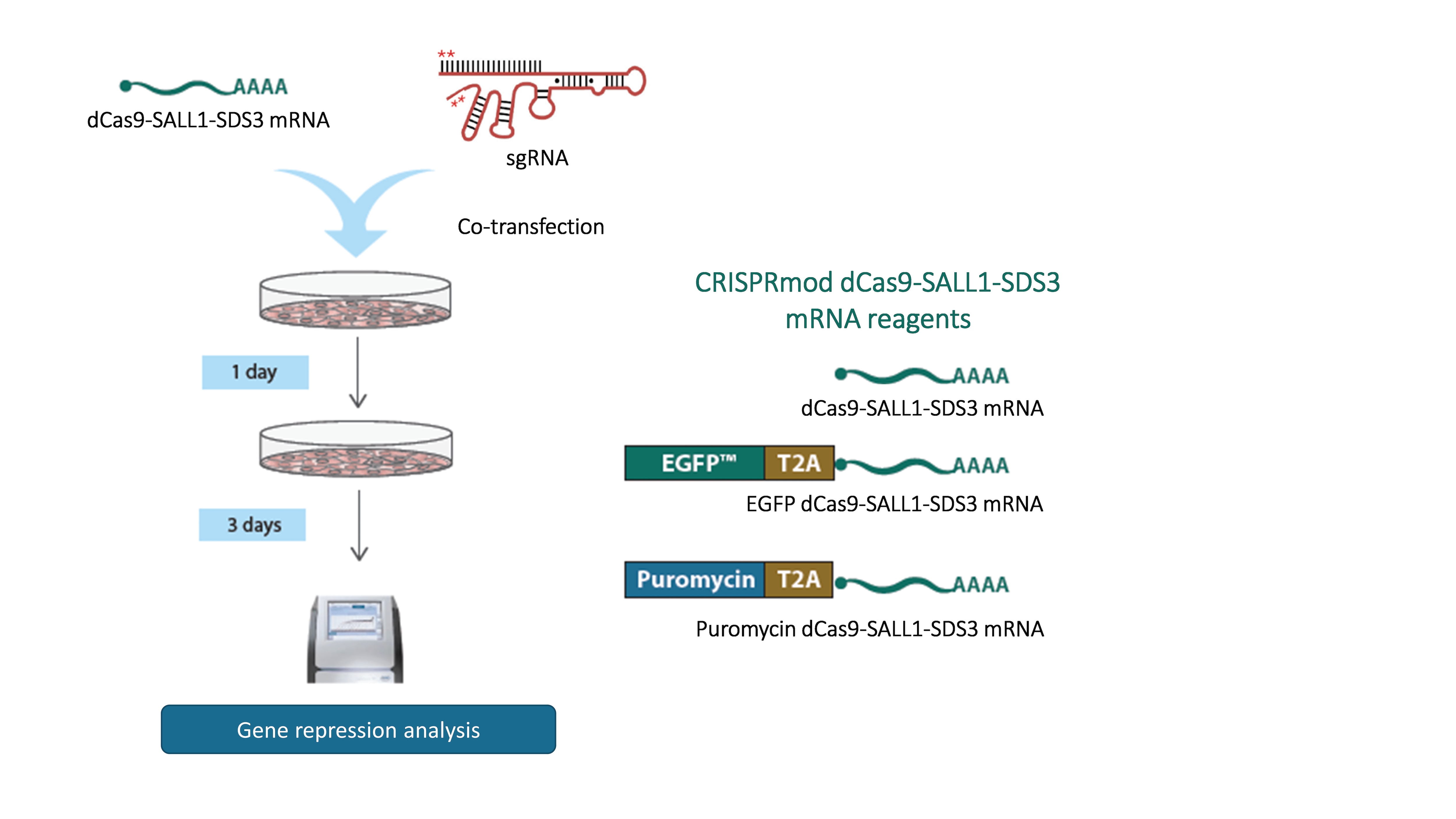
CRISPRi workflow using synthetic sgRNA and dCas9-SALL1-SDS3 mRNA
Transduce cells with dCas9-SALL1-SDS3 lentiviral particles to generate CRISPRi-ready, stable dCas9-SALL1-SDS3 expressing cells. Then introduce CRISPRi synthetic sgRNA specific to your target gene(s). This system is ideal for screening, extended time point assays or when working with difficult-to-transfect cell types.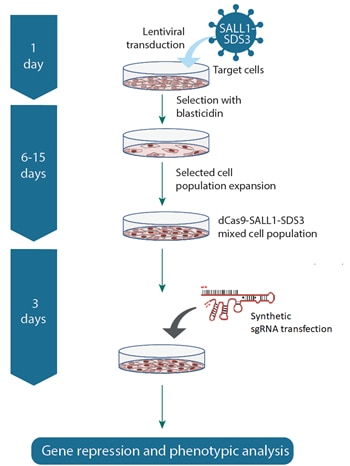
CRISPRi workflow using synthetic sgRNA and dCas9-SALL1-SDS3 lentiviral particles
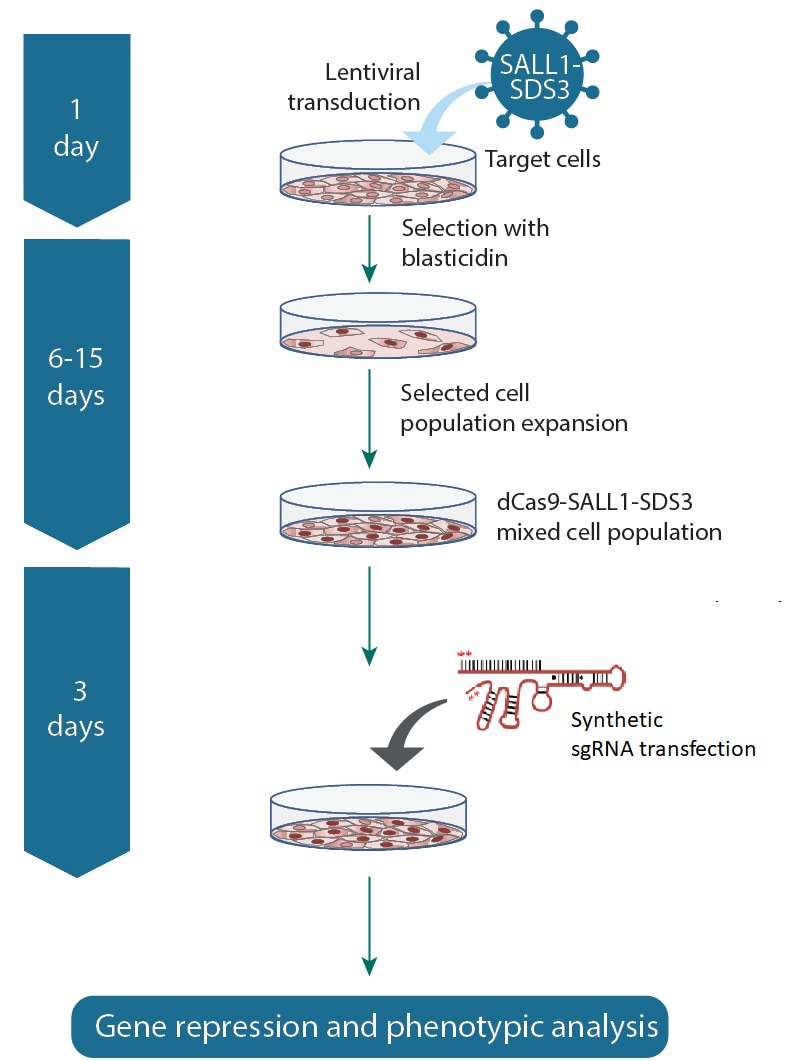
CRISPRi workflow using synthetic sgRNA and dCas9-SALL1-SDS3 lentiviral particles
Complete your CRISPRi experiment by adding these supporting reagents to your order
CRISPRi dCas9-SALL1-SDS3
- CRISPRi dCas9-SALL1-SDS3 mRNA can be co-transfected with CRISPRi synthetic sgRNA for a fully DNA-free workflow.
CRISPRi synthetic guide RNA controls
- CRISPRi synthetic sgRNA non-targeting controls are used to evaluate baseline cellular responses to CRISPRi components in the absence of target-specific sgRNA. Choose from 5 scrambled sequences guaranteed not to target any gene in the human genome.
- CRISPRi synthetic sgRNA positive controls targeting well-characterized genes are used to determine the effectiveness of your experimental conditions for maximum repression. Choose from PPIB or SEL1L1.
Transfection reagents
- DharmaFECT transfection reagents are optimized for improved delivery and reduced toxicity. The optimal DharmaFECT reagent for your experiment will depend on your Cas9 nuclease source and your cell type.
| dCas9-SALL1-SDS3 source | Recommended transfection reagent |
|---|---|
| dCas9-SALL1-SDS3 lentiviral particles | DharmaFECT 1,2,3, or 4 for transfection of synthetic guide RNA. Use this guide to find the recommended DharmaFECT reagent for your cell type. |
| dCas9-SALL1-SDS3 mRNA | DharmaFECT Duo for co-transfection of mRNA or protein and synthetic guide RNA |
CRISPRmod CRISPRi synthetic sgRNAs achieve maximal repression at 48-72 hours post-transfection in both dCas9-KRAB and Cas9-SALL1-SDS3-expressing cells. U2OS cells stably expressing integrated dCas9-KRAB or dCas9-SALL1-SDS3 were plated at 10,000 cells/well and transfected using DharmaFECT 4 Transfection Reagent with pools of pre-designed synthetic sgRNA (25nM) targeting CBX1, HBP1, or SEL1L. Cells were harvested at 24, 48, 72, 96, 120, and 144 hours post-transfection, total RNA was isolated, and relative gene expression was measured using RT-qPCR. The relative expression of each target gene was calculated with the ∆∆Cq method using GAPDH as the housekeeping gene and normalized to a non-targeting control (NTC).CRISPRi gene repression is observed 24 hours post-transfection and is maximal 48-72 hours post transfection
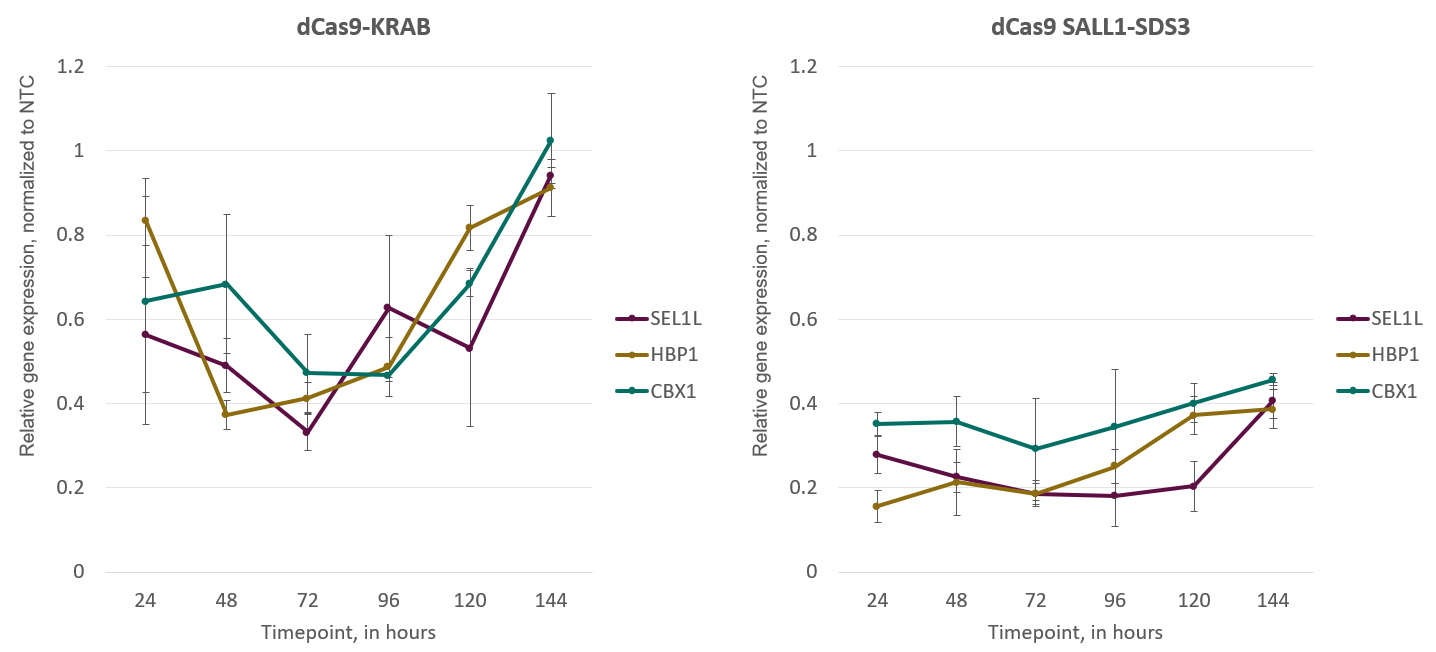
CRISPRi gene repression is observed 24 hours post-transfection and is maximal 48-72 hours post transfection
Individual CRISPRmod CRISPRi sgRNAs achieve robust target gene repression independently, but when pooled together in a single reagent, display enhanced repression levels. U2OS cells stably expressing integrated dCas9-SALL1-SDS3 were plated at 10,000 cells/well and transfected using DharmaFECT 4 Transfection Reagent with synthetic sgRNA targeting BRCA1, PSMD7, SEL1L, or ST3GAL4. The pre-designed sgRNAs were used either individually or pooled (to a total concentration of 25 nM). Cells were harvested 72 hours post-transfection, total RNA was isolated, and relative gene expression was measured using RT-qPCR. The relative expression for each gene was calculated with the ∆∆Cq method using GAPDH as the housekeeping gene and normalized to non-targeting control (NTC).Pooling synthetic sgRNA enhances CRISPRi activity
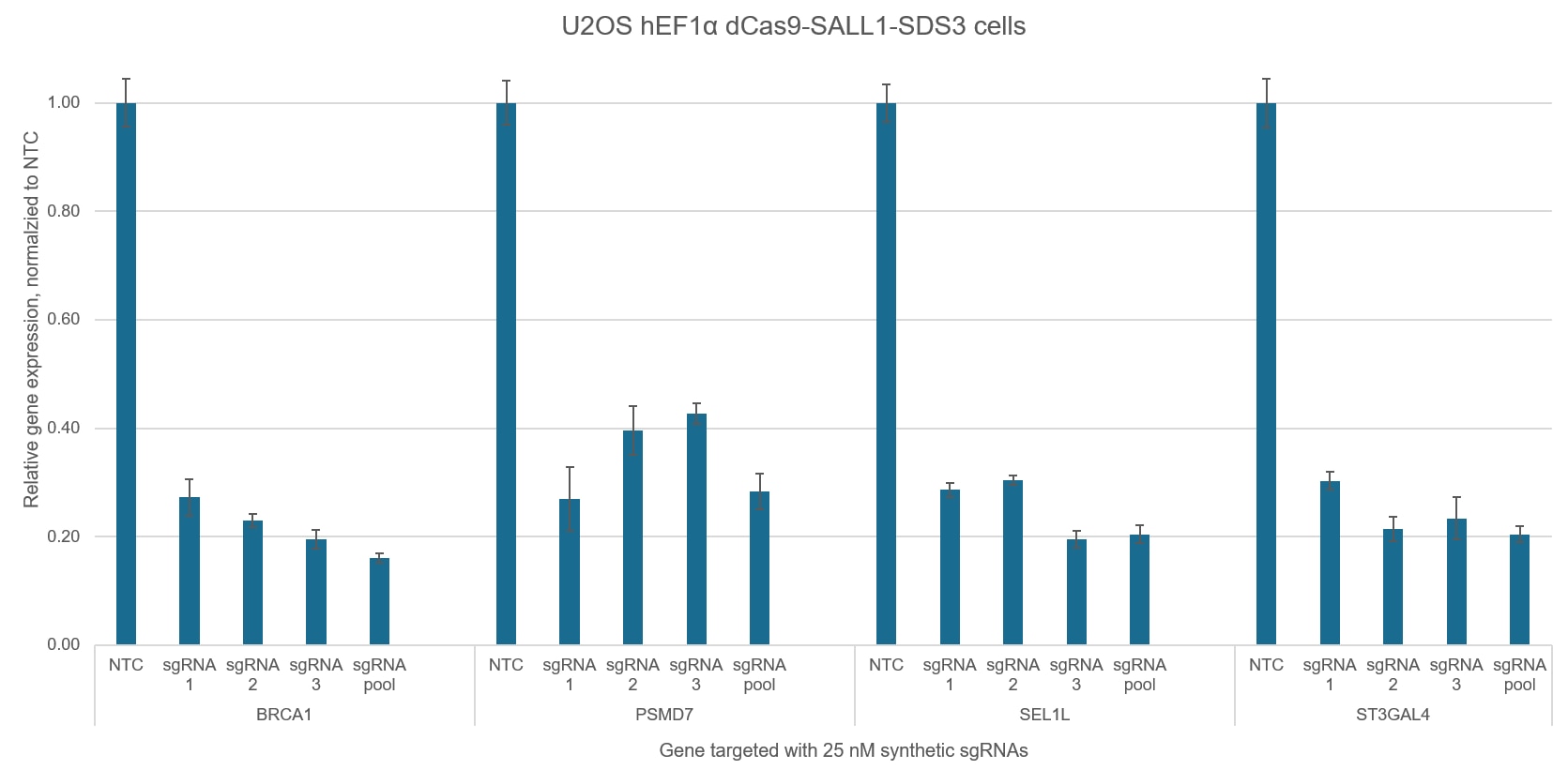
Pooling synthetic sgRNA enhances CRISPRi activity
CRISPRi transcriptional repression varies by gene but does not appear to be dependent on endogenous expression levels. Data has been compiled from multiple transfections performed in U2OS cells stably expressing integrated dCas9-SALL1-SDS3 with the following matching conditions. Cells were plated at 10,000 cells/well and transfected using DharmaFECT 4 Transfection Reagent with synthetic sgRNA pools (25 nM) targeting 21 genes with different basal levels of expression. Cells were harvested 72 hours post-transfection, total RNA was isolated, and relative gene expression was measured using RT-qPCR. The relative expression of each target gene was calculated with the ∆∆Cq method using GAPDH as the housekeeping gene and normalized to a non-targeting control (NTC). The CRISPRi-mediated target gene repression is shown in the left graph where the genes are ordered from low to high level of basal transcript expression. In the right graph target gene expression is plotted against fragments per kilobase of transcript per million (FPKM), a representation of basal gene expression based on RNA-Seq data from the parental U2OS cell line. In U2OS cells PPIB is expressed at a basal level roughly one hundredfold greater than that of SOX2, but both genes can be repressed to roughly 20-25 percent of their basal expression with CRISPRmod CRISPRi reagents.CRISPRi transcriptional repression varies by gene but appears to be independent of endogenous expression levels
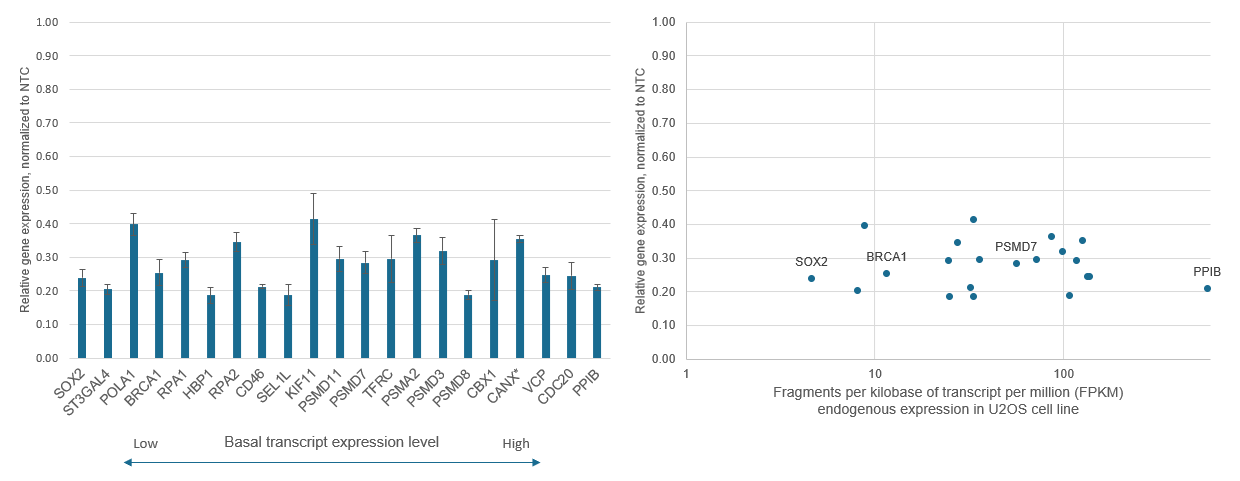
CRISPRi transcriptional repression varies by gene but appears to be independent of endogenous expression levels
- M. A. Horlbeck et al., Compact and highly active next-generation libraries for CRISPR-mediated gene repression and activation. eLife. 5, e19760 (2016). https://doi.org/10.7554/eLife.19760
- C. Mills et al., A Novel CRISPR interference effector enabling functional gene characterization with synthetic guide RNAs. The CRISPR Journal. Vol 5, [6] (2022). http://doi.org/10.1089/crispr.2022.0056
Protocols
Quick protocols
Safety data sheets
Technical manuals
Related Products
Validated CRISPRi synthetic pools or individual sgRNA for optimization of transcriptional repression experiments.
Validated CRISPRi synthetic pools or individual sgRNA for evaluation of transcriptional repression experiments.

